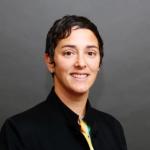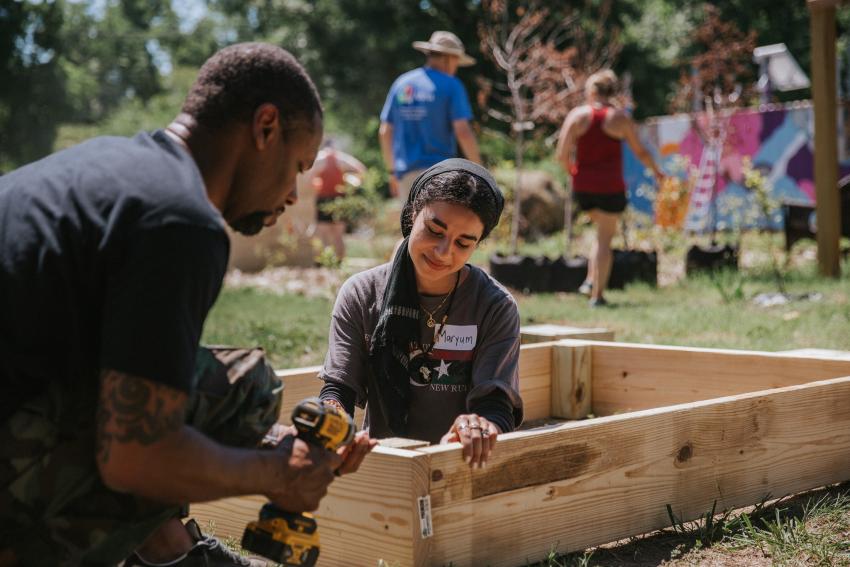Vanessa Diamond is answering Stephanie Andrieux’s questions.
How was HandsOn a Greater Richmond (HandsOn RVA) created ?
In the 2000’s I moved from Portland, Oregon, to Richmond, Virginia, after I had served a few years of AmeriCorps1. Back then I was working on my Master’s degree in public administration and nonprofit management while working at the local university, Virginia Commonwealth University. I kept trying to volunteer, something that was a huge part of my life back in Portland. In Richmond, it felt really difficult. Even on MLK Day2, the largest national service day in the United States, I couldn’t find a way to volunteer.
I discussed it with two friends, Kristen Kaplan and Elaine Summerfield, and we wanted to do something about it. We were extremely lucky to find each other and to have the right amount of difference in talent. I had been in the volunteer service field, Elaine had worked for foundations and Kristen had nonprofit management experience.
Between 2006 and 2007, we started what we called Activate Richmond. We modeled it after what we knew from other cities: HandsOn Portland, HandsOn Atlanta, Boston Cares, etc. These volunteer hubs all had similar models with calendars and done-in-the-day projects. We simply replicated it.
And that was the funny part: people in Virginia thought we had a great new idea. Well, we didn't make this up but thank you. We were just learning from what other communities tried. Also, we are so grateful for the help we received from the other affiliates in the now Points to Light Network3. They showed us how they did their budgets and their program models. They even handed us their binders and their folders.
What were your first steps in implementing this model ?
From planning volunteer projects, we started developing a volunteer leader project program where other people would lead the projects out in the community. And the next thing I knew we had a website and a database. Kristen, Elaine, and I had full-time jobs, we were paying our Internet web hosting bill with $200 that we raised at a barbecue backyard party.
We got to the next step with a phone call from Points of Light, called HandsOn Network at the time. They had a corporate partner in the region that was interested in seed-funding us. It allowed us to launch a volunteer hub in our region.
Within a few years, we started having major events with thousands of volunteers. We engaged between 10 and 15,000 volunteers annually. Keep in mind Richmond is a pretty small city, there are 250,000 inhabitants in the city. The bigger HandsOn RVA got, the more complex our work became. Today, we work with corporate partners and universities, we do a lot of capacity-building for nonprofits, and we also run leadership programs.
How would you describe your work today ?
We have evolved to focus on helping the people that want to do good in our community to build the skills and the knowledge to be able to do so. So we have a whole suite of programs that fall under this umbrella: not only for individuals, but also nonprofits, corporate partners, faith-based institutions, and universities. We play a connective tissue between all of those entities to create a better ecosystem for how we show up in our community.
We became what I call an anchor organization: we convene different organizations on a specific issue because that effort’s curation is vital. Everyone's got good intentions and is trying to mobilize resources to have an impact. What we need is a collective impact, a model in which the foundations’, nonprofits’, community organizations’, and governments’ efforts are aligned and aggregated.
Did making volunteer connections change along the way ?
When we started, we were mainly doing calendar projects that were short-term for the individual volunteer, but a long-term commitment on our part with the nonprofit partners, who knew they could rely on a group of volunteers to come every Thursday or every third Monday, whatever the need was. It allows volunteers to come one time or more.
We still do this type of programming, because it's really important to keep doing these sorts of programs: we all have busy lives and I don’t want to say no to anyone, whether they have an hour a week or an hour a year. We all need to be able to show up, without judgment. HandOn RVA is here to help create a pathway for any community member that wants to be involved in their community.
But the evolution for us has been about being this connective tissue. For example, we now run a project called RVA Engage. It's a coalition of corporate partners engaging their employees, university staff engaging their faculty and their students, and civic leadership groups.
Why do these people, whose job is to mobilize volunteers, need to talk to each other ?
Because these amplifiers need a place to share practices and questions: how do we do this better and more efficiently? What kind of technology should we use ? How do we do this with an equity lens ? How do we think about the power dynamics between institutions of higher education, or corporate partners, and local communities, or communities of color ? And can we be more conscious of the way that we are stepping forward ?
One of our objectives is for these companies and nonprofits to create mobilization initiatives that respond to true community needs. We want to make sure they listen to the community voices and are not just showing up and saying : « This is what we are going to bring to you ». We want their relationships to be much more of an exchange. By now we have realized this is going to take time because the work we do right now is really about cultural and behavioral change.
This is important because those entities mobilize tens of thousands of volunteers. HandsOn RVA might mobilize 10 to 15,000 volunteers within its volunteer matching system. Working with all of these corporate partners and universities brings amplification and a scale of influencing, not just what we do but how we choose to do it: for me, that’s systematic change. We are helping them change the intention of how they show up, and that means we are changing the relationships we have with each other, and that’s long-standing.
What are the main ingredients to build such a trustful relationship ?
Let’s take an example: youth volunteerism. Often we look at youths’ needs, but we don’t listen to what they want. Instead of adults deciding what youth should get, ask them directly. I've got young children, 13 and 16 years old, and I'm really in awe of how capable they are. Ask the youths what they need after school, they might lead the after-school programming themselves. It doesn't have to be an external adult that's coming in. We don’t recognize the power they have to give.
Often we look at communities that are traditionally thought of as communities being served: the unhoused, those who lack access to resources, or those who speak a different first language, and we think they are the people that are going to get volunteer services or donations. But often, those are the people who, if engaged effectively, are the most likely to make a real change.
So far, we don't do it well in the US, or anywhere I would say because it's hard. It takes time, it takes relationship building, it takes listening, and it also takes an ego drop from the nonprofit sector and the government sector. Our sectors need to stop believing that we have the answer because we most likely have only a piece of the answer. Everyone’s got a role.
We had a great example of this dynamic in Richmond with an employment initiative in a deprived community. Nonprofits offered job training and transportation to the members of the community. Classic nonprofit solutions. When they finally asked residents what they needed, it was childcare because of swing shifts. Of course, the nonprofit workers didn’t think of that because they don’t work night shifts, they are not living it and so far they didn't ask. When we talk about inclusivity, I think it's about asking and being curious.
Looking back on the recent history of the United States, have you seen things change in civic engagement and the nonprofit sector over the presidencies of Barack Obama, Trump, and now Joe Biden ?
I think that the tone has changed in the last four years, but not necessarily due to any president. We have elevated our sense of « I » versus the sense of « We ».
When you take the alignment of climate change, the pandemic, racial reckoning, plus our political environment, and lack of trust in each other and institutions, something has changed in the tone of volunteering. Today when we talk to families, they need to get their children involved. Parents want their kids to understand what's going on in the world so they can take action. There is a similar urge in schools, churches, and companies. Particularly after the pandemic, community engagement feels more urgent to many people.
Paradoxically, volunteering hours have radically dropped in the US. First, nonprofits couldn't have anyone during the pandemic. But, since then, the numbers have not gone back up. There are a couple of reasons why, including that people are exhausted. The pandemic we navigated over the last couple of years, whether you lost someone, you were sick or you were impacted by the economic crisis because of it, was an exhausting experience. We're all still recovering from it, and are unable to show up in the world. Our social networks shrunk very tiny, and we're probably still building our way back.
In the United States, something else has radically changed our field, it's the murder of George Floyd and the much-needed racial awakening that followed. As long as I have ever been in the sector, racial issues have been discussed, including systematic and institutional racism. But those issues were not as much at the forefront as there are now.
Racial reckoning and awakening have solidified the idea that people within their communities need to have a say. This is a radical change for the philanthropic and nonprofit sectors in the United States. Today, American nonprofits are asking themselves tough questions : where are we stepping forward, where we should be stepping back, and where do we shift to the last? Who else should be doing this work ? Should we not be doing this work ?
We can’t answer it without including Black, indigenous, and people of color’s (BIPOC) voices. It means for those of us that are white to stop and listen differently, as we always should have. It is time to ask ourselves some hard questions about how our sector needs to do things differently.
- 1AmeriCorps is a national service program in the United States, focused on building bridges and engaging young Americans in a year of service.
- 2Martin Luther King, Jr. Day (MLK Day) is a day of service to honor the life and work of Martin Luther King, Jr. In 1994, MLK Day became a federal holiday, and it is still the only one designated as a National Day of Service to encourage all Americans to volunteer to improve their communities.
- 3Founded in 1990 by then-President George H.W. Bush, the Points of Light Foundation is a nonpartisan organization encouraging service. In 1992 HandsOn Atlanta, New York Cares and Greater DC Cares founded CityCares (later named HandsOn Network) as an umbrella organization to provide a national network for sharing resources. In 2007, Points of Light Foundation and HandsOn Network merged to become Points of Light, creating the largest civic engagement organization in the United-States.


